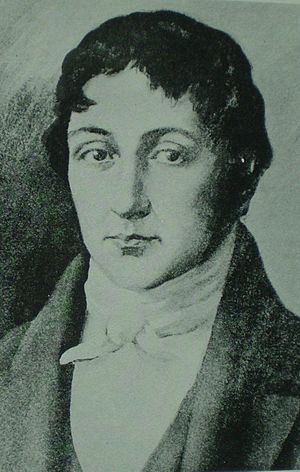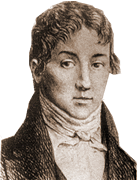Manuel de Sarratea facts for kids
Quick facts for kids
Manuel de Sarratea
|
|
|---|---|
 |
|
| 2nd Governor of Buenos Aires Province | |
| In office 18 February 1820 – 6 March 1820 |
|
| Preceded by | Matías de Irigoyen |
| Succeeded by | Juan Ramón Balcarce |
| 4th Governor of Buenos Aires Province | |
| In office 11 March 1820 – 2 May 1820 |
|
| Preceded by | Juan Ramón Balcarce |
| Succeeded by | Ildefonso Ramos Mexía |
| Personal details | |
| Born | 11 August 1774 Buenos Aires |
| Died | 21 September 1849 (aged 75) Limoges, France |
| Nationality | Argentine |
Manuel de Sarratea was an important Argentine diplomat, politician, and soldier. He was born in Buenos Aires on August 11, 1774, and passed away in Limoges, France, on September 21, 1849.
Manuel came from a wealthy family. His father, Martin de Sarratea, was a very rich merchant in Buenos Aires. His sister, Martina de Sarratea, married Santiago de Liniers, who was a high-ranking Spanish official in the region.
Contents
Early Life and First Triumvirate Role
Manuel de Sarratea studied in Madrid, Spain. After his education, he returned to Argentina to work as a diplomat. He played a part in the May Revolution of 1810, which was a key step towards Argentina's independence.
With advice from Manuel Belgrano, a famous Argentine leader, Sarratea became an ambassador in Río de Janeiro, Brazil. When the first government body, the Primera Junta, was dissolved, he returned home. He then joined the next government, known as the First Triumvirate.
One of the Triumvirate's main achievements was signing a treaty with the Spanish viceroy, Francisco Javier de Elío. This treaty gave the Banda Oriental (which is now Uruguay) back to the Spanish crown.
Challenges with José Artigas
In 1812, the treaty was broken after a change in government in Montevideo. The war against the royalists (people loyal to Spain) started again. Many local soldiers, called Criollos, had left the area with their leader, José Artigas.
Sarratea took charge of the army in the Banda Oriental. His main goal was to get Artigas's troops to return. He tried to convince Artigas, and when that didn't work, he even tried to bribe him. Both attempts failed. Sarratea then declared Artigas a traitor, but the other members of the Triumvirate disagreed with this decision.
The Triumvirate was mostly led by minister Bernardino Rivadavia. It eventually fell in October 1812. Sarratea continued to lead the army in the Banda Oriental until early the next year. He was then replaced by José Rondeau. Only after Sarratea left did Artigas and his men return to help with the siege of Montevideo.
Diplomatic Missions to Europe
Sarratea was not active in politics for over two years. Then, in 1815, the Supreme Director, Gervasio Posadas, sent him on important diplomatic missions. He traveled to Madrid and London.
In Spain, he met with King Ferdinand VII, who had recently returned to power. Sarratea offered to have the United Provinces (Argentina) rejoin the Spanish crown, but with some self-rule. However, the king saw him as a representative of rebels. So, Sarratea had to leave Spain and go to England.
Governor of Buenos Aires
Sarratea returned to Buenos Aires in mid-1816. He was appointed as the foreign relations minister for the Supreme Director, Juan Martín de Pueyrredón. He later resigned due to health issues.
After resigning, he started making connections with political groups that opposed the Director. Because of this, he was expelled from the country and sent to Montevideo.
Becoming Governor
After the Battle of Cepeda in 1820, Sarratea joined the federalist army. This army was led by Estanislao López and Francisco Ramírez. They sent him as their representative to the Buenos Aires Cabildo (a local government council). Sarratea convinced the Cabildo to name him governor of the province.
He became governor on February 18, 1820. Soon after, he signed the Treay of Pilar with the federalist leaders. This treaty recognized the Buenos Aires Province as equal to the other United Provinces.
Challenges as Governor
One secret part of the treaty was that Sarratea promised to give weapons to the federalist leaders. When the Buenos Aires military found out about this, they rebelled against him. They removed him from power on March 6, replacing him with General Juan Ramón Balcarce. Sarratea was governor for only one week.
However, General Ramírez threatened to attack the city if they didn't deliver the promised weapons. So, Sarratea became governor again on May 11. He also gave Ramírez some military units led by Colonel Lucio Norberto Mansilla.
Sarratea struggled to control the constant chaos in the province. He couldn't gain the trust of the military. Because of these difficulties, he was forced to resign at the end of May.
He then joined Ramírez's army in a campaign against Artigas. Defeating Artigas was probably his biggest personal success. Later, he helped prepare for a war Ramírez would fight against Buenos Aires, Santa Fé, and Córdoba. This war ended badly for Ramírez. After this, Sarratea stepped away from politics for a while.
Later Diplomatic Missions
On August 31, 1825, Juan Gregorio de Las Heras appointed Sarratea as a commercial representative to Great Britain.
In 1826, President Rivadavia sent him to London again as Argentina's representative. While there, he supported Britain's idea of separating the Banda Oriental from the rest of the provinces. This separation happened in 1828, creating the country of Uruguay.
Governor Manuel Dorrego kept him as ambassador. Later, Juan Manuel de Rosas named him ambassador to Brazil and France.
See also
 In Spanish: Manuel de Sarratea para niños
In Spanish: Manuel de Sarratea para niños


